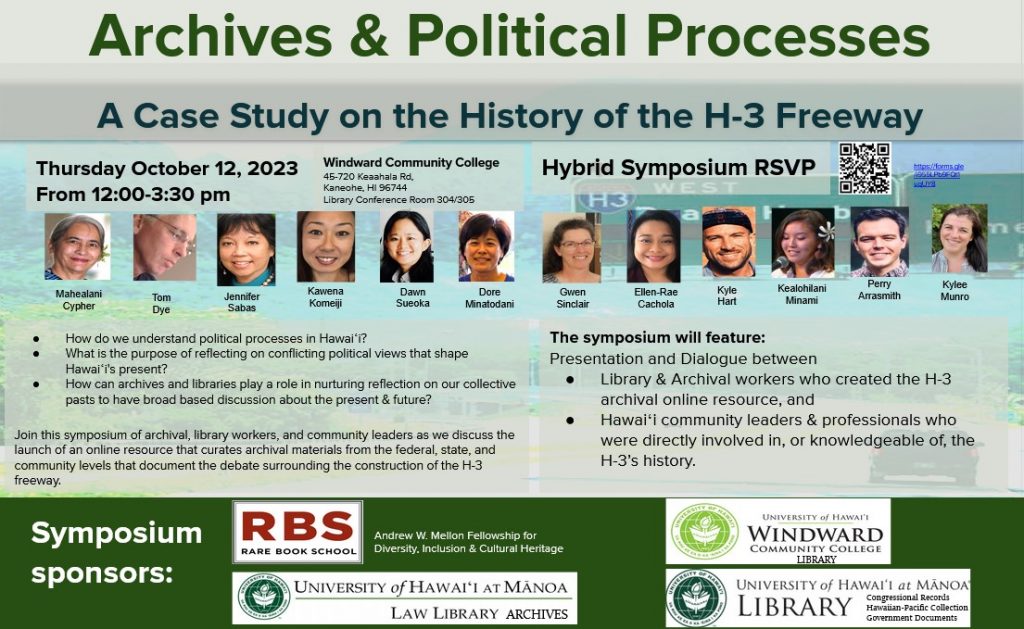Introduction
We hear about many political processes in the news: contested cases, environmental reviews, hearings, injunctions, and protests. These intersecting processes can be convoluted, confusing, and opaque. What is also challenging for the public is that the documentation of these processes is located in many different places, such as University of Hawaiʻi libraries and archives; the Hawaiʻi State Archives; the Hawaiʻi Documents Center at the Hawaiʻi State Library; the National Archives; within federal, state, and county agencies; and, in some cases, in private hands.
Whether you want to research a Hawaiʻi political issue or get involved in advocating for or against a proposed project, it is important to understand these processes and how they interconnect to affect a project’s development and outcome. This website, created by librarians, archivists, and students at the University of Hawaiʻi at Mānoa, uses the John A. Burns Freeway (also known as the H-3 Freeway) as a case study to explore these processes and to connect the public with documentation of these processes.
The H-3 is a 16-mile freeway connecting Oʻahu’s Kāneʻohe Marine Corps Base with the H-1 freeway near Joint Base Pearl Harbor-Hickam. It cost $1.3 billion to build, and it was opened to the public in 1997, 37 years after it was first conceptualized in a congressional report.
We selected the H-3 as a case study because it exemplifies the interaction between community groups, three levels of government (local, state, and federal), and all three branches of government (legislative, executive, and judicial). Further, the period during which the H-3 was built, 1960-1997, was a transformative one in the U.S. and in Hawaiʻi. These years saw a growing awareness of the need to protect our environment and cultural resources. This period also saw a burgeoning of Native Hawaiian activism and mobilization around land and cultural issues. The H-3 was, therefore, a flashpoint for conflicting (and sometimes aligning) priorities and interests, such as protecting sacred cultural sites, managing development and population growth, creating jobs, protecting national security, and protecting the environment. It also highlighted tensions and conflicts among groups such as Native Hawaiian activists, community advocates, the government, industry, and the military.
We do not intend this website to be a comprehensive history of H-3. Instead, we present a curated set of resources and frameworks that you can use to research, understand, and engage with the histories of other large political projects in Hawaiʻi. Indeed, as people, voters, students, activists, interest groups, leaders, and public servants, we have the power and responsibility to shape decisions about land and how it is used. This website’s ultimate goal is to support the public in becoming more informed, engaged, and effective participants in political processes in Hawaiʻi.
How to Use This Website
This website is divided into five major sections, which can be explored in any order:
- A brief history: An overview of the development and construction of the H-3.
- Timeline: The timeline presents key events in the history of H-3. The timeline can be searched; it can also be filtered by political process (e.g., legislative process, judicial process), and by party (e.g., Hawaiʻi Department of Transportation, Bishop Museum). Additionally, clicking on most timeline events will reveal links to digitized documents, library resources, and GIS imagery.
- Processes: Pages in this section describe the interrelated political processes that affected the development of the H-3: Kanaka, Legislative, Regulatory, Contested Case, Judicial, Opposition, and Support. With the exception of the Kanaka and Opposition process pages, each process page begins by describing the process in general terms, and then describes it in the context of the H-3. The pages also identify where researchers can locate documentation of each process.
- Collections: Overviews of the archival collections in Hawaiʻi and on the continent that contain material relating to the history of the H-3.
- Parties: Descriptions of the major organizations, government agencies, and other entities involved in the history of the H-3.
Watch the recording of our October 12, 2023 symposium, which publicly launched this resource. The archivists, librarians, and students behind this project reflected on how and why they created this resource, and professionals and community leaders who directly experienced the political processes behind the H-3 history provided feedback.
